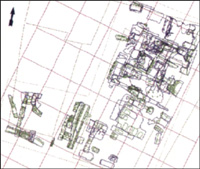 Urban archaeology investigates the origin, growth and recession of cities using thorough investigation and
recording
of archaeological evidence before its destruction by modern development.
Urban archaeology investigates the origin, growth and recession of cities using thorough investigation and
recording
of archaeological evidence before its destruction by modern development.
 The project Urban Archaeology in Beirut '94 provides a unique opportunity for young Lebanese archeologists
to gain experience in the latest methods and techniques of excavating city centers. The urban archaeology now
brought to Beirut was developed over the last 20 years and tested abroad, in England and France, in London and
Carthage, as well as in Rome and Milan. Mastering urban archaeology will in the future enable Lebanese
archaeologists to retrieve information from other important cultural capitals of Lebanon's past,
continuously occupied since antiquity, and hence difficult to investigate
with traditional excavation techniques. Today's urban archaeology allows
the retrieval of delicate finds and samples providing evidence of urban
activities and life in ancient Beirut, as well as the visual reconstruction of
entire buildings despite the fact that only small portions of the city can be
freed because of the high cost of urban excavations.
The project Urban Archaeology in Beirut '94 provides a unique opportunity for young Lebanese archeologists
to gain experience in the latest methods and techniques of excavating city centers. The urban archaeology now
brought to Beirut was developed over the last 20 years and tested abroad, in England and France, in London and
Carthage, as well as in Rome and Milan. Mastering urban archaeology will in the future enable Lebanese
archaeologists to retrieve information from other important cultural capitals of Lebanon's past,
continuously occupied since antiquity, and hence difficult to investigate
with traditional excavation techniques. Today's urban archaeology allows
the retrieval of delicate finds and samples providing evidence of urban
activities and life in ancient Beirut, as well as the visual reconstruction of
entire buildings despite the fact that only small portions of the city can be
freed because of the high cost of urban excavations.
 However, Lebanon's cultural heritage cannot be properly managed
without the public at large. Hence, results of archaeological rescue work
must be communicated to the public
immediately, if general interest and
support is to be raised. A poster campaign
in Arabic and English providing
information about the aims and results of
the 1994 urban excavation on Souk Tawile
began in September on site.
However, Lebanon's cultural heritage cannot be properly managed
without the public at large. Hence, results of archaeological rescue work
must be communicated to the public
immediately, if general interest and
support is to be raised. A poster campaign
in Arabic and English providing
information about the aims and results of
the 1994 urban excavation on Souk Tawile
began in September on site.
 G-SYS plan showing superimposed
G-SYS plan showing superimposed
Ottoman and Mamluk period structures
and features excavated in succession
on the Souk Tawile site by AUB-Leverhulme
team.
|





